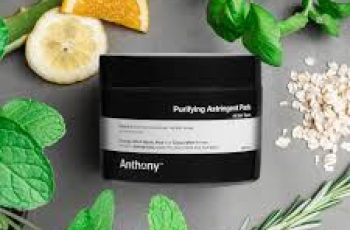
10 Reasons You Should Switch to Natural Deodorant
Natural deodorant, maybe you already know and use it, maybe you’ve never heard of it, or maybe you’re researching it? Whatever it is, here are 10 reasons why you should switch to natural deodorant!
1. Aluminum
Antiperspirant deodorants often contain a variety of ingredients, such as: B. Aluminum, which actually prevents the body from sweating by clogging the sweat glands and trapping toxins in the body. Over time, this can develop into cell mutations and is believed to be a cause of cancer. So, instead of aluminum, natural deodorants contain a lot of natural ingredients that are actually good for the skin, allowing it to breathe freely without clogging the pores and sweat glands.
2. Parabens
Parabens are another ingredient that is commonly found in antiperspirants. They are used as preservatives in many other skin care products, cosmetics, and even foods. Parabens can also cause imbalances in the body because they act very similarly to estrogen, so they can disrupt the body’s hormonal balance. This has been linked to the development of breast cancer because it most often occurs in the outer upper quadrant, the area where the deodorant is used. Natural deodorants are paraben-free, so if any of the above concerns you, switching to a natural deodorant will be very helpful.
3. Fragrance
A nicely scented deodorant is undoubtedly what everyone wants. However, the word fragrance is often used very loosely in certain products and actually refers to many other ingredients full of toxins and chemicals that can irritate and damage the skin, especially the sensitive underarm skin. You may be considering choosing a fragrance-free antiperspirant, but unfortunately, this does not mean that the above chemicals are still lurking in the product. The smell or aroma you find in natural deodorants comes from the plants and other natural ingredients in the product.
4. Sensitivity
The armpits have to endure a lot every day: they are washed, scrubbed, and sometimes shaved, and then constantly come into contact with friction and irritating materials. It’s no wonder that your armpits can become very sensitive and sometimes even develop painful rashes. Using antiperspirants can lead to further irritation, redness, and sensitivity due to the many chemicals and fragrances contained in the product. By using a natural deodorant that contains a range of natural ingredients, essential oils, and other skin-soothing products, your underarms will be treated without suffering further adverse reactions!
5. Painful Bumps
Given the sensitivity of the armpits, it’s no surprise that using antiperspirants can also lead to bumps and rough skin. Since antiperspirants essentially prevent the pores and sweat glands from producing sweat, this can lead to bacteria and product buildup, resulting in underarm bumps and sometimes even blemishes. These can also cause issues when shaving, as the skin surface is not flat, so there is a higher chance of razor burn. When the skin is able to breathe and the pores and sweat glands are not clogged, the skin texture won’t be bumpy and painful bumps and blemishes won’t appear. This means your underarms will look more attractive, too!
VI. Benefits
Natural deodorant is a great product because the more you use it, the more it benefits your skin. When the glands and pores are able to function properly and produce sweat, you’ll find that you can go a day without using deodorant! You’ll also notice that your underarm skin feels smoother, the shave is closer to the skin, and it lasts longer, too.
7. Detox
It may sound a little strange to say that switching to a natural deodorant will allow you to completely detox your underarms. But it makes sense and will bring huge benefits to the overall appearance and health of your underarms. When switching from antiperspirants to natural deodorants, it is best to detox for a few days. This allows any toxins and chemicals that the antiperspirant has trapped in your armpits to be completely expelled from your body. Detoxification can be a little unsettling, and if you are concerned about body odor, you can use essential oils such as coconut oil and lavender to mask any odor without causing further problems. After a few days, you can try your new natural deodorant and you will definitely love it!
8. Work with your body
Finding an antiperspirant that works for you and your body can be a daunting task. Since the ingredients are basically the same, you will find that if one doesn’t work for you, the others may not work either. Natural deodorants are made from a variety of natural ingredients. So this is your chance to try a few of them and find one that gives you excellent results. Maybe tea tree oil is good for you? Or maybe charcoal works wonders for your underarms? Charcoal in deodorant may sound unusual, but it is a great alternative to other ingredients like aluminum and parabens.
9. Packaging
This may be something you haven’t considered or wanted to change. Antiperspirants and roll-on deodorants come in non-recyclable packaging and are sometimes even made from non-recyclable plastic. You’ll find that some natural deodorants also come in plastic packaging, but the packaging is simple and usually recyclable and can be recycled. You’ll also notice that some are made from glass, which is a material that is easier to recycle. Procoal’s natural activated charcoal deodorant balm comes in a glass jar and contains no plastic. So not only is the balm safe and gentle on the skin, it’s also good for the environment.
10. No More Stains
There’s nothing worse than putting on your little black dress and finding lots of white deodorant stains on the sides! They simply can’t be removed and ruin the look you were going for. The final benefit of switching to a natural deodorant is that this problem will be a thing of the past and your outfit will be perfect!
So there you have it, 10 reasons why you should switch to a natural deodorant. Whether it’s for health reasons, because it makes your armpits look better, or even to help the environment, whatever it is, you won’t regret it!


